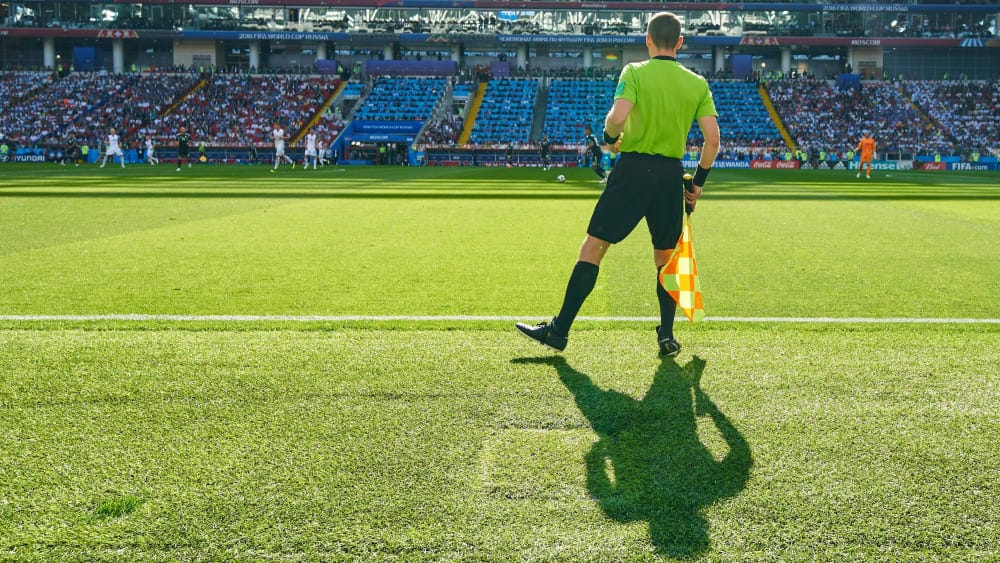After extensive testing, it is clear that semi-automatic offside technology will be used at the World Cup in Qatar. It should lead to faster decisions, better inform the spectators and is based on two core elements.
Now it will be used in a prominent place after all, the chip in the ball. It had lost out to camera systems in the goal-line technology, but now it is at least one of two core elements of the semi-automatic offside technology. A sensor in the centre of the official World Cup ball transmits ball data to the video centre 500 times per second, which makes it possible to precisely determine the rule-relevant first contact when playing or touching the ball.
The rest is taken care of by an optical detection system. Twelve special tracking cameras installed under the stadium roofs will capture the ball and up to 29 data points of each player’s body 50 times per second in Qatar to determine their exact position. The data points will cover all extremities and limbs relevant to offside decisions.
“Robot referees? That’s not the case “
Artificial intelligence combines both sets of data. After a goal is scored, the VAR team receives information within a few seconds as to whether a player of the attacking team, including the goal scorer, was in an offside position during the attack in question.
According to FIFA refereeing chief Pierluigi Collina, this purely technically generated “offside” signal is then validated by the VAR team through its own review of the slow-motion footage and examined for punishability. For all the joy about the new technology, Collina was keen to emphasise one thing during an international media round: “I have read about robot referees and similar things. But that is not the case. The referees are still making the decisions, they just have a new technical help. “
Collina’s ultimate goal: “Correct decisions on the pitch “
The VAR team has to clarify, for example, whether the ball was played by the teammate or the opponent and whether a relevant opponent contact with the ball was deliberate or unintentional in order to answer the question of punishability. According to Collina, the ultimate goal remains to “ultimately make correct decisions on the pitch”. That is why he will continue to work intensively with the referees on the quality of decisions, also irrespective of the technique, for example in handball or foul situations.
For the technical “offside warning” on the VAR screens, Collina expects similarly accurate and reliable results as with the goal-line technology, which determines the position of the ball to within a few millimetres and almost in real time. The semi-automatic offside technology has already been tested at the FIFA Arab Cup in Qatar in December 2021 and at the Club World Cup in the United Arab Emirates in February 2022.
“We gained very positive experience with the technology there, but will of course continue to work on the best possible application until the start of the World Cup,” says Collina. This is especially true for the 36 referees nominated for the global title matches and their assistants around the German FIFA referee Daniel Siebert as well as the 24 World Cup VARs around Marco Fritz and Bastian Dankert.
Significant costs – From 2023/24 also in the Bundesliga?
At the World Cup, eight people will work in the video centre per match, the VAR and three assistants including offside experts plus four operators. In addition to the personnel, the costs are also considerable. FIFA does not want to give exact figures, but Johannes Holzmüller, Director of Technology and Innovation at the world governing body, explains with regard to three years of development time and the latest software and hardware: “Every new technology is expensive at the moment of introduction, but over time the costs will drop significantly. The price of goal-line technology per stadium, for example, was four times as high during the first test during the 2002 World Cup as it is today. In general, we hope that in the future as many competitions as possible will be able to use this technology as a support.”
The investment in offside technology is expected to pay off quickly, for the protagonists – and the spectators. “We are aware that it sometimes takes too long to check possible offside situations, especially when the offside decision is very close,” admits Collina, who expects the average time for an offside check to drop from the current 70 seconds to around 25 seconds in future. On top of that, for greater understanding and transparency, animated 3D graphics based on the positional data will be displayed on both the stadium screens and the TV broadcasts during the following stoppage, providing a precise breakdown of the offside position.





